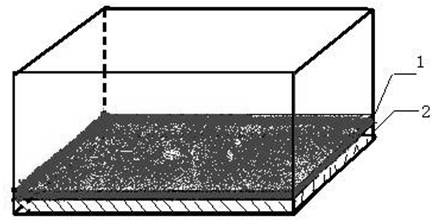Method for cage culture of frogs
A technology for cage farming and frogs, applied in animal husbandry and other directions, can solve the problems of difficult control of water temperature in breeding ponds, low survival rate of frogs, and lack of habitat, so as to prevent frogs from dying, improve disease resistance, and remove pond pests. Effect
- Summary
- Abstract
- Description
- Claims
- Application Information
AI Technical Summary
Problems solved by technology
Method used
Image
Examples
Embodiment 1
[0023] Follow these steps:
[0024] 1. Species selection: Collect and breed tiger frogs that have been disease-free and strong for 2 years, weighing 250 grams for female frogs and 200 grams for male frogs, and place them in a moisturizing pool with a constant temperature of 20 degrees Celsius for breeding;
[0025] 2. Oviposition: Put 10 female frogs and 10 male frogs into the pond to mate and lay eggs;
[0026] 3. Tadpole cultivation: add 100 tablets of oxytetracycline and dry yeast to water for disinfection 5 days in advance. The hatched tadpoles are put into net cages at 600 / square meter and fed with tadpole powder for 10 days; at 300 / square meter cages, continue to be fed with tadpole powder for 1 month;
[0027] 4. Raising adult frogs: Adult frogs are raised in net cages at a density of 15 / square meter. After the tadpoles metamorphosis, they start to feed the frogs, and they can be sold when they are raised to 0.25 kg each. Described net cage is 6 meters long, 3 meters...
Embodiment 2
[0033] Follow these steps:
[0034] 1. Species selection: Collect and breed American bullfrogs that have been disease-free and strong for 3 years. The female frogs weigh 470 grams and the male frogs 400 grams as seed frogs. They are raised in a moisturizing pool with a constant temperature of 25 degrees Celsius;
[0035] 2. Oviposition: Put 10 female frogs and 5 male frogs into the pond to mate and lay eggs;
[0036] 3. Tadpole cultivation: add 100 tablets of oxytetracycline and dry yeast to water for disinfection 7 days in advance. The hatched tadpoles were raised in cages at 300 per square meter, and fed with tadpole powder for 7 days; at 150 per square meter, the cages were changed and continued to be fed with tadpole powder for 1 month;
[0037] 4. Raising adult frogs: Adult frogs are raised in net cages at a density of 5 / square meter. After the tadpoles metamorphosis, they start to feed the frogs, and they can be slaughtered when they are raised to 0.5 kg each. Polyure...
Embodiment 3
[0043] Follow these steps:
[0044] 1. Species selection: Collect and breed tiger frogs that have been disease-free and strong for 5 years. The female frogs weigh 230 grams and the male frogs 220 grams as seed frogs. They are raised in a moisturizing pool with a constant temperature of 30 degrees Celsius;
[0045] 2. Oviposition: Put 5 female frogs and 5 male frogs into the pond to mate and lay eggs;
[0046] 3. Tadpole cultivation: add 100 tablets of oxytetracycline and dry yeast to water 10 days in advance for disinfection. The hatched tadpoles are raised in cages at a rate of 500 per square meter, and fed with tadpole powder for 7 days; at 250 per square meter, the cage is changed and the tadpole powder is fed for 1 month;
[0047]4. Raising adult frogs: Adult frogs are raised in net cages at a density of 10 / square meter. After the tadpoles metamorphosis, they start to feed the frogs, and they can be sold when they are raised to 0.25 kg each.
[0048] 5. The whole proces...
PUM
 Login to View More
Login to View More Abstract
Description
Claims
Application Information
 Login to View More
Login to View More - R&D Engineer
- R&D Manager
- IP Professional
- Industry Leading Data Capabilities
- Powerful AI technology
- Patent DNA Extraction
Browse by: Latest US Patents, China's latest patents, Technical Efficacy Thesaurus, Application Domain, Technology Topic, Popular Technical Reports.
© 2024 PatSnap. All rights reserved.Legal|Privacy policy|Modern Slavery Act Transparency Statement|Sitemap|About US| Contact US: help@patsnap.com









